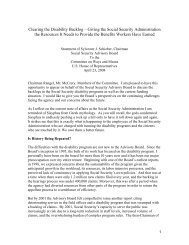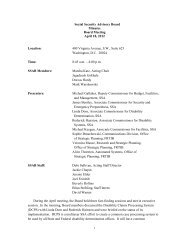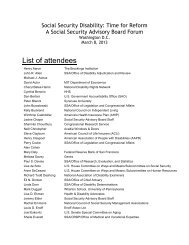Aspects of Disability Decision Making: Data and Materials
Aspects of Disability Decision Making: Data and Materials
Aspects of Disability Decision Making: Data and Materials
You also want an ePaper? Increase the reach of your titles
YUMPU automatically turns print PDFs into web optimized ePapers that Google loves.
2002 In Barnhart v. Walton, 535 U.S. 212 (2002), the Supreme Court upheld SSA’s interpretation <strong>of</strong> the12-month duration <strong>of</strong> disability requirement in the statutory definition <strong>of</strong> disability. Walton hadclaimed that the 12-month requirement was met if an individual had a medical impairment thatlasted for 12 months, even if the person’s inability to work did not last for 12 months. SSA interpretedthe law as requiring that the inability to work must last, or be expected to last, 12 months.In its decision, the Court agreed with SSA. It also upheld SSA’s longst<strong>and</strong>ing policy precluding afinding <strong>of</strong> disability when a claimant returns to work within the 12‐month period after onset <strong>of</strong>an impairment <strong>and</strong> prior to the agency making the initial decision on the application.2003 In Barnhart v. Thomas, 540 U.S. 20 (2003), the Supreme Court upheld SSA’s interpretation <strong>of</strong> thestatutory definition <strong>of</strong> disability as it related to past work. When finding that a claimant was notdisabled because he or she could return to his or her previous work, SSA did so without investigatingwhether the person’s previous work existed in significant numbers in the national economy.Thomas had argued that the statutory provision that referred to work that exists in significantnumbers applied to decisions based on the ability to do past work.SSA implemented a new business process to streamline updates to its Listing <strong>of</strong> Impairments <strong>and</strong>to increase outside participation in developing listings’ revisions. The initiative called for:■■greater internal agency review <strong>of</strong> newly revised listings;■■publishing Advance Notices <strong>of</strong> Proposed Rule <strong>Making</strong> to seek public input before proposingspecific changes, <strong>and</strong>■■holding public outreach events giving medical experts, claimants, <strong>and</strong> advocates an opportunityto comment on the agency’s medical criteria.2004 The Social Security Protection Act <strong>of</strong> 2004 (P.L. 108‐203) included a range <strong>of</strong> provisions, some <strong>of</strong>which were related to the work incentives <strong>and</strong> assistive services stemming from The Ticket to Work<strong>and</strong> Work Incentives Improvement Act <strong>of</strong> 1999. These included a technical amendment to the TicketAct, exp<strong>and</strong>ed waiver authority in connection with demonstration projects, <strong>and</strong> a requirementthat SSA issue receipts to disabled beneficiaries each time they reported their work <strong>and</strong> earnings.The Act also made benefits planning, assistance <strong>and</strong> outreach services <strong>and</strong> protection <strong>and</strong> advocacyservices available to beneficiaries in SSI 1619(b) States, to those individuals receiving a (SSI)State supplement payment, <strong>and</strong> to those in an extended period <strong>of</strong> Medicare eligibility.SSA began to roll out a new electronic disability claim processing system. The system, renamedAccelerated Electronic <strong>Disability</strong> (AeDib), used a paperless electronic claim folder to store medicalrecords <strong>and</strong> other documents that had always been maintained in a paper folder. It featured:■■■■■■■■Internet applications;electronic data collection;electronic folders, accessible to all users, to store all claim information; <strong>and</strong>automated case processing <strong>and</strong> management system.2005 In January 2005, Mississippi became the first State to implement Social Security’s new fully electronicdisability application process under its AeDib initiative.The Deficit Reduction Act <strong>of</strong> 2005 (P.L. 109 171) required SSA to review a specific percentage <strong>of</strong>favorable initial SSI disability <strong>and</strong> blindness decisions made by DDSs with respect to individualsaged 18 <strong>and</strong> older. The reviews would be conducted before any implementation action. The lawrequired SSA to review 20 percent <strong>of</strong> the allowances in 2006, 40 percent in 2007, <strong>and</strong> 50 percentin 2008 <strong>and</strong> thereafter.<strong>Aspects</strong> <strong>of</strong> <strong>Disability</strong> <strong>Decision</strong> <strong>Making</strong>: <strong>Data</strong> <strong>and</strong> <strong>Materials</strong> 99









